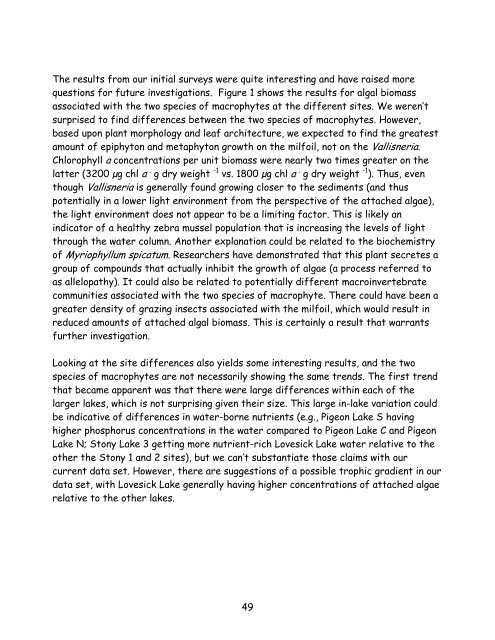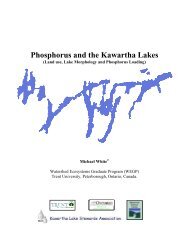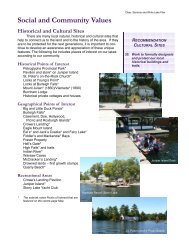Lake Water Quality 2006 Report - Lakefield Herald
Lake Water Quality 2006 Report - Lakefield Herald
Lake Water Quality 2006 Report - Lakefield Herald
Create successful ePaper yourself
Turn your PDF publications into a flip-book with our unique Google optimized e-Paper software.
The results from our initial surveys were quite interesting and have raised morequestions for future investigations. Figure 1 shows the results for algal biomassassociated with the two species of macrophytes at the different sites. We weren’tsurprised to find differences between the two species of macrophytes. However,based upon plant morphology and leaf architecture, we expected to find the greatestamount of epiphyton and metaphyton growth on the milfoil, not on the Vallisneria.Chlorophyll a concentrations per unit biomass were nearly two times greater on thelatter (3200 µg chl a . g dry weight -1 vs. 1800 µg chl a . g dry weight -1 ). Thus, eventhough Vallisneria is generally found growing closer to the sediments (and thuspotentially in a lower light environment from the perspective of the attached algae),the light environment does not appear to be a limiting factor. This is likely anindicator of a healthy zebra mussel population that is increasing the levels of lightthrough the water column. Another explanation could be related to the biochemistryof Myriophyllum spicatum. Researchers have demonstrated that this plant secretes agroup of compounds that actually inhibit the growth of algae (a process referred toas allelopathy). It could also be related to potentially different macroinvertebratecommunities associated with the two species of macrophyte. There could have been agreater density of grazing insects associated with the milfoil, which would result inreduced amounts of attached algal biomass. This is certainly a result that warrantsfurther investigation.Looking at the site differences also yields some interesting results, and the twospecies of macrophytes are not necessarily showing the same trends. The first trendthat became apparent was that there were large differences within each of thelarger lakes, which is not surprising given their size. This large in-lake variation couldbe indicative of differences in water-borne nutrients (e.g., Pigeon <strong>Lake</strong> S havinghigher phosphorus concentrations in the water compared to Pigeon <strong>Lake</strong> C and Pigeon<strong>Lake</strong> N; Stony <strong>Lake</strong> 3 getting more nutrient-rich Lovesick <strong>Lake</strong> water relative to theother the Stony 1 and 2 sites), but we can’t substantiate those claims with ourcurrent data set. However, there are suggestions of a possible trophic gradient in ourdata set, with Lovesick <strong>Lake</strong> generally having higher concentrations of attached algaerelative to the other lakes.49





